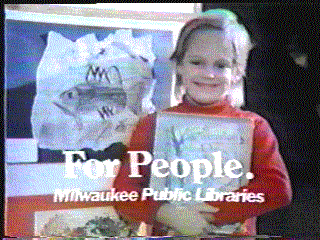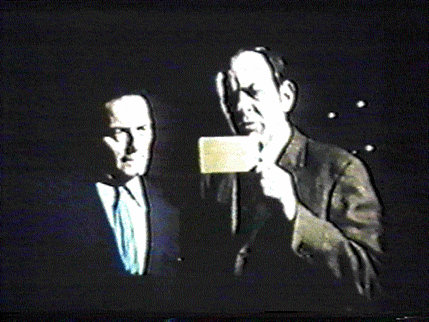Early Markets: Arts and Charities, and Public Service Announcements
My friend and client Mike Krawczyk from the Milwaukee Repertory Theater called it “Clubbing Your Way Up.” Early on, word of mouth spread from Arts groups to Charitable organizations that we had a way to get them in front of audiences or on TV cheaply. We developed a reputation as problem solvers, at a time when ad agencies and PR firms stayed away from “business” audio-visuals. Public Service Announcements and fundraising slide shows were not yet looked upon by agencies as creative opportunities, but we understood that they could open doors, by showing our wares to folks who attended plays in the evening and ran companies in the daytime.
The Milwaukee Rep.


PIE: The Milwaukee Rep’s Bill McKerighan delivers a standard PSA season ticket pitch, then announces that he wants to make “the spot more memorable”.
SPLAT! “Hmm”, says Bill….”Lemon Meringue!”

SCROOGE: Henry Strozier, as Scrooge, is interviewed by the late Larry Shue, portraying “trusted Anchorman Bob Cratchit”. For the Rep’s “A Christmas Carol”

“DECEPTION! IS THAT ALL THERE IS TO LIFE?!?”, adlibs a character portrayed by Larry Shue in voiceover, as a bewildered potential Rep subscriber (voiced by Penny Reed) who lives out her fantasies. A takeoff on Artistic Director John Dillon’s heavy Eugene O’Neill season.
The Milwaukee Symphony.


GREAT SEATS: Two buddies compare “season tickets”. One’s thinking baseball, the other, Brahms. Kenneth Schermerhorn wants you.
The Milwaukee Public Library.



FOR PEOPLE: “Library People are everyday people”… take that, Toyota. This series defined us… it was twin dissolve slides, with classic Ric Sorgel photography, constant dissolves, killer British library music, Steve Lutomski narration (sped up to fit 30 seconds) and that sweet face at the end. Who was she? Where is she today? Dave Sorgel cameos as a record-listening hipster.
Goodwill Industries


“FIRE AT GOODWILL”. No verbs necessary. Written by SLR writer Dan Melton, who didn’t believe (rightfully so) in full sentences.
Goodwill needs your help, so we can get back to work. It worked.
The Swine Flu

HIT BACK: Where were you when the swine flu hit? Did it hit? Remember the swine flu? It was going to plunge us into the next worldwide plague. Didn’t happen. But we got the swine flu PSA account, and used some popular populist approaches, like having a couple of the Packers tell us to hit the flu before it hits us. The Packers. That always works — even in the Dan Devine era.



THE GAMBLER: Ok, so, as a New Jersey boy and a certified former hippy, I hated pro sports. (Try wrenching me away from the TV on Sundays now). SO I came up with an alternative — the gambler, so lucky he’ll take his chances with the flu, standing under the patented Monty Python 5000 lb. weight. One problem — this prop was not tricked up — it had a solid bottom. But actor Larry Roscioli knew how to take a fall — luckily!
Milwaukee Public Museum



Steve Lutomski’s take on “Taking a Look At Yourself”. The businessman learns about society through the dioramas at the museum, which curiously, feature statues that look quite like him!
For many of these clients, we produced twin dissolve slide shows to be the basis of their fundraising efforts, and Public Service Announcements to up their recognition on TV.
Why were we so lucky to land these accounts? TV stations had not yet begun to look on PSA’s as a tool to boost recognition of their news teams, or to up their images as people who “cared”. They just ran the spots cause they had to, in order to comply with the terms of their licenses. Most PSA’s were terrible. We tried to make them more interesting, even when produced on a shoestring. The stations usually donated production time to boot, so all we had to do was show up with our raw materials, our script, (I usually pre-produced the soundtrack), the on-screen talent if there was any, and go for it. It was a lot of fun, and at the TV stations, we got to meet local celebrities like Doctor Cadaverino, Father Gene Jakubek, and Howard Gernette.
In the mid-seventies, the classic “industrial” media, particularly for corporate communications, were films and filmstrips. Budget and need usually determined which would be the chosen medium. And Sorgel-Lee-Riordan produced many films and filmstrips, in addition to our staple of “twin dissolve” programs. Rob Riordan provided excellent work for Harley Davidson; Linda Duczman wrote and directed films for the county; I even got to do a video for WLS in Chicago. We were lucky to have bread and butter accounts like Cutler-Hammer, Preway, Nekoosa, and the sewerage district, where the information was clearly more important than technique — but they paid regularly, and as the business grew, we knew we needed that.

Rob Riordan at the Steenbeck flatbed editor, which proved we were really into motion projects. Here’s a sample:
Wisconsin Library Association


DRAGNET: Larry Roscioli, part of the SLR stock troupe (which is another way of saying we’ll pay you 25 bucks and dinner), is a library user accused of theft in a Dragnet takeoff for the Wisconsin Library Association. “Joe Friday” and “Sgt. Frank Gannon” examine the evidence — a library card.
Ric, meanwhile pursued the flaky technology of an emerging field: multi-image. Although we had produced many “multimedia” shows featuring 10 or 15 or 20 projectors, each of these was a risk. Usually, these were for business meetings or sales events and were operated by us on site as well, to reduce the risk. We had success with shows for the Journal, TV6, and the Credit Union Executives’ Society.

But the biggest risk had been the previously mentioned Milwaukee Art Museum’s Urban River exhibit show — 8 screens in the round — a show that played at the Art Museum (the Art Center) for months, leading the debate on revitalizing Milwaukee’s Riverfront (it took twenty years, but it worked. We take full credit :)).
Ric’s vision was to embrace a technology that other competitors were afraid of, thereby distinguishing us further. It was a marketing approach that worked, but also worked to begin to emphasize the technology over the message. For the next five years, we tried to balance all of the media in which we communicated. Balance in terms of financial investment, labor investment, and marketing investment. Eventually, there would be a winner: “multi-image”.
— — — — — — — — — — — — — — — — — — — — — — — — — —
Click Here for a video look at a few of the above-described PSAs.



